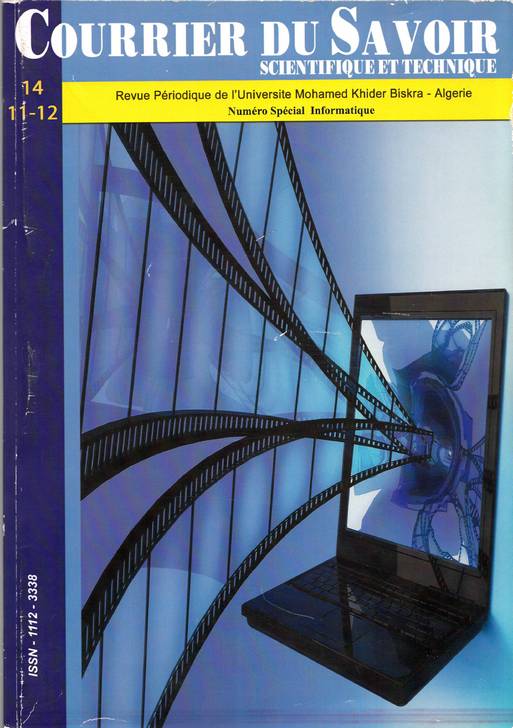AODV EXTENSION USING MULTI POINT RELAY FOR HIGH ERFORMANCE ROUTING IN VANETS
Résumé
VANETs (Vehicular Ad-hoc Networks) are wireless networks where vehicles (car, bus, truck) form the nodes of the network.Recently, for driver comfort and road safety, the inter-vehicle communication became increasingly a subject of much scientific
research. On VANETs, routing protocols have a great consequence; AODV [1] is one of the most popular routing protocol
dedicated for ad-hoc networks; it uses the flooding technique for locating the destinations, and so, possibly cause an overhead
in the network. To overcome this problem we have introduced the MPR (Multi Point Relay) [2] algorithm in the AODV
protocol in order to reduce the number of messages broadcasted during the flooding phase. Simulations under NS2 have been
conducted using parameters that proximate the reality such as: a freeway topology, a dynamic mobility with high speed (over
90 km/h) and high traffic density. The simulation results show that the extended AODV (AODVM) using MPR reduces the
load and performs better than the standard in case of dense traffic with low and high speeds
Références
T. AMIOUR & al.
24
Intelligent Vehicles Symposium, 2003.
[8] Seet. B.-C., Liu. G., Lee. B.-S., Foh. C. H., Wong. K. J,
and Lee. K.-K. “A-STAR: A Mobile Ad Hoc Routing
Strategy for Metropolis Vehicular Communications”,
NETWORKING, 2004.
[9] Z. HAAS, M. PEARLMAN and M. SAMAR, “The Zone
Routing Protocol (ZRP) for Ad Hoc Networks”, IETF
Internet draft, draft-ietf-manet-zone-zrp-04.txt, July 2002
[10] Wu. H., Fujimoto. R., Guensler. R, and Hunter. M.
“MDDV: A Mobility-Centric Data Dissemination
Algorithm for Vehicular Networks”, ACM VANET, 2004.
[11] Network Simulator – NS2, http://www.isi.edu/nsnam/ns/
[12] Clausen. T., and Jacquet. P “Optimized Link State
Routing Protocol (OLSR)”, IETF, Request for Comments
3626, October 2003.
[13] F. Bai, N. Sadagopan, and A. Helmy. “User manual for
important mobility tool generators in ns-2 simulator”,
2004. [1] Perkins. C, Belding-Royer E., and Das S.. “Ad hoc On-
Demand Distance Vector (AODV) Routing”, Network
Working Group, July 2003 available on:
ftp://ftp.nordu.net/rfc/rfc3561.txt.
[2] ZHU. W. “Multipoint Relay flooding” Mast er of Science
Thesis Stockholm, Sweden TRITA-ICT-EX-2009:5.
[3] Haerri. J., Filali. F., and Bonnet. C “Mobility Models for
Vehicular Ad Hoc Networks: A Survey and Taxonomy”,
Institut Eurecom, RR-06-168.2006
[4] [4] Hui. F. “A survey on the characterization of Vehicular
Ad Hoc Networks and routing solutions”, ECS 257 -2005.
[5] Li. C.-T et al. “A secure and efficient communication scheme
with authenticated key establishment and privacy preserving
for vehicular adhoc networks”,Comput Commun,
doi:10.1016/j.comcom.2007.12.05.
[6] Li. F,and Wang. Y..”Routing in Vehicule Ad Hoc
Networks: Asurvey” in IEEE vehicular technology
magazine, 2007.
[7] Lochert. C., Hartenstein. H., Tian. J., D. Herrmann,
Fubler. H. and Mauve. M: “A Routing Strategy for
Vehicular Ad Hoc Networks in City Environments”, IEEE
24
Intelligent Vehicles Symposium, 2003.
[8] Seet. B.-C., Liu. G., Lee. B.-S., Foh. C. H., Wong. K. J,
and Lee. K.-K. “A-STAR: A Mobile Ad Hoc Routing
Strategy for Metropolis Vehicular Communications”,
NETWORKING, 2004.
[9] Z. HAAS, M. PEARLMAN and M. SAMAR, “The Zone
Routing Protocol (ZRP) for Ad Hoc Networks”, IETF
Internet draft, draft-ietf-manet-zone-zrp-04.txt, July 2002
[10] Wu. H., Fujimoto. R., Guensler. R, and Hunter. M.
“MDDV: A Mobility-Centric Data Dissemination
Algorithm for Vehicular Networks”, ACM VANET, 2004.
[11] Network Simulator – NS2, http://www.isi.edu/nsnam/ns/
[12] Clausen. T., and Jacquet. P “Optimized Link State
Routing Protocol (OLSR)”, IETF, Request for Comments
3626, October 2003.
[13] F. Bai, N. Sadagopan, and A. Helmy. “User manual for
important mobility tool generators in ns-2 simulator”,
2004. [1] Perkins. C, Belding-Royer E., and Das S.. “Ad hoc On-
Demand Distance Vector (AODV) Routing”, Network
Working Group, July 2003 available on:
ftp://ftp.nordu.net/rfc/rfc3561.txt.
[2] ZHU. W. “Multipoint Relay flooding” Mast er of Science
Thesis Stockholm, Sweden TRITA-ICT-EX-2009:5.
[3] Haerri. J., Filali. F., and Bonnet. C “Mobility Models for
Vehicular Ad Hoc Networks: A Survey and Taxonomy”,
Institut Eurecom, RR-06-168.2006
[4] [4] Hui. F. “A survey on the characterization of Vehicular
Ad Hoc Networks and routing solutions”, ECS 257 -2005.
[5] Li. C.-T et al. “A secure and efficient communication scheme
with authenticated key establishment and privacy preserving
for vehicular adhoc networks”,Comput Commun,
doi:10.1016/j.comcom.2007.12.05.
[6] Li. F,and Wang. Y..”Routing in Vehicule Ad Hoc
Networks: Asurvey” in IEEE vehicular technology
magazine, 2007.
[7] Lochert. C., Hartenstein. H., Tian. J., D. Herrmann,
Fubler. H. and Mauve. M: “A Routing Strategy for
Vehicular Ad Hoc Networks in City Environments”, IEEE
Comment citer
MED TAHAR, AMIOUR; AZEDDINE, BILAMI.
AODV EXTENSION USING MULTI POINT RELAY FOR HIGH ERFORMANCE ROUTING IN VANETS.
Courrier du Savoir, [S.l.], v. 14, mai 2014.
ISSN 1112-3338.
Disponible à l'adresse : >https://revues.univ-biskra.dz/index.php/cds/article/view/406>. Date de consultation : 26 avr. 2025
Rubrique
Articles


